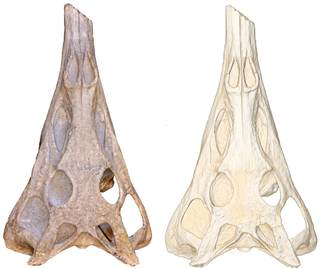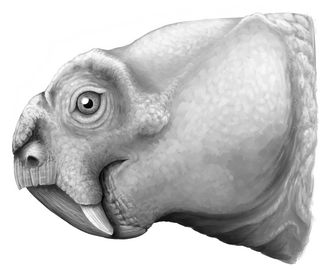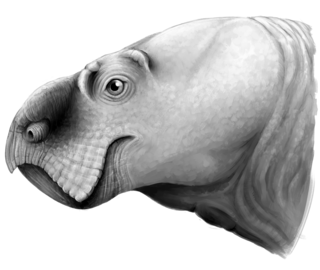
Herrerasauridae is a family of carnivorous dinosaurs, possibly basal to either theropods or even all of saurischians, or even their own branching from Dracohors, separate from Dinosauria altogether. They are among the oldest known dinosaurs, first appearing in the fossil record around 233.23 million years ago, before becoming extinct by the end of the Carnian stage. Herrerasaurids were relatively small-sized dinosaurs, normally no more than 4 metres (13 ft) long, although the holotype specimen of "Frenguellisaurus ischigualastensis" is thought to have reached around 6 meters long. The best known representatives of this group are from South America, where they were first discovered in the 1930s in relation to Staurikosaurus and 1960s in relation to Herrerasaurus. A nearly complete skeleton of Herrerasaurus ischigualastensis was discovered in the Ischigualasto Formation in San Juan, Argentina, in 1988. Less complete possible herrerasaurids have been found in North America and Africa, and they may have inhabited other continents as well.

Paleorhinus is an extinct genus of widespread basal phytosaur known from the Late Triassic. The genus was named in 1904 based on the type species Paleorhinus bransoni, which is known from Wyoming and Texas in the United States. Another valid species, Paleorhinus angustifrons from Bavaria, Germany, is also commonly referred to the genus. Paleorhinus had a length of about 2.5 meters.

Stahleckeriidae is a family of dicynodont therapsids whose fossils are known from the Triassic of North America, South America, Asia and Africa.

Dinodontosaurus is a genus of dicynodont therapsid. It was medium to large dicynodont of the Triassic and had a beak corneum. It lived in the Middle Triassic but disappeared in the Upper Triassic.

Dolichuranus is an extinct genus of dicynodont therapsids from the Middle Triassic Omingonde Formation of Namibia and the Ntawere Formation of Zambia.

Moghreberia is an extinct genus of dicynodont predicted to have lived only in the mid-Triassic, primarily during the early middle Carnian and found only in the Argana Basin of Morocco. Moghreberia belonged to the Stahleckeriidae family, a group of anomodont therapsids and is most commonly known by its species Moghreberia nmachouensis. Its name is derived from the Arabic phrase al-Maghrib al-Aqsa meaning “the far west”, a term used by Arabic scholars to refer to the approximate region of Morocco, the area in which this animal’s fossil was first discovered. The extinction of many dicynodonts has been attributed to pressures of the Carnian Pluvial Episode, which occurred around 234-232 Ma and generated major ecological and climate changes for years to come.
Elephantosaurus is an extinct genus of dicynodont from the Middle Triassic (Ladinian) Bukobay Formation. The holotype and only known specimen, catalogued as PIN 525/25, is a fragment of the skull that includes portions of the left interorbital region and nasal bones, and suggests a very large animal with a skull at least 30 centimetres (12 in) wide. The bones of the skull roof are also unusually thick. While usually considered a member of the Stahleckeriidae, generally due to its size, it probably falls just outside the group due to its frontal bone contributing substantially to the margin of the eye socket.
Sangusaurus is an extinct genus of large dicynodont synapsid with two recognized species: S. edentatus and S. parringtonii. Sangusaurus is named after the Sangu stream in eastern Zambia near to where it was first discovered + ‘saur’ which is the Greek root for lizard. Sangusaurus fossils have been recovered from the upper parts of the Ntawere Formation in Zambia and of the Lifua Member of the Manda Beds in Tanzania. The earliest study considered Sangusaurus a kannemeyeriid dicynodont, but more recent phylogenetic analyses place Sangusaurus within the stahleckeriid clade of Dicynodontia. Until recently, little work had been done to describe Sangusaurus, likely due to the fact that only four incomplete fossil specimens have been discovered.
Zambiasaurus is an extinct genus of dicynodonts that was discovered in the Middle Triassic (Anisian) Ntawere Formation of Zambia, southern Africa. It was a large dicynodont, reconstructed using several fossil fragments, in majority belonging to probably a juvenile Zambiasaurus submersus.
The Popo Agie Formation is a Triassic geologic formation that crops out in western Wyoming, western Colorado, and Utah. It was deposited during the Late Triassic in fluvial (river) and lacustrine (lake) environments that existed across much of what is now the American southwest. Fragmentary fossils of prehistoric reptiles and amphibians, including pseudosuchian reptiles and temnospondyl amphibians, have been discovered in the Popo Agie Formation. Dinosaur remains are also among the fossils that have been recovered from the formation, although none have yet been referred to a specific genus.

Kannemeyeriiformes is a group of large-bodied Triassic dicynodonts. As a clade, Kannemeyeriiformes has been defined to include the species Kannemeyeria simocephalus and all dicynodonts more closely related to it than to the species Lystrosaurus murrayi.

Smok is an extinct genus of large carnivorous archosaur. It lived during the latest Triassic period. Its remains have been found in Lisowice, southern Poland. The only species is Smok wawelski and was named in 2012. It is larger than any other known predatory archosaur from the Late Triassic or Early Jurassic of central Europe. The relation of Smok to other archosaurs has not yet been thoroughly studied; it may be a rauisuchid, prestosuchid, an ornithosuchid pseudosuchian or a theropod dinosaur.

Eubrachiosaurus is an extinct genus of stahleckeriid dicynodont known from the Late Triassic of Wyoming, United States.
The Stuttgart Formation is a geologic formation in Germany. It preserves fossils dating back to the Carnian stage of the Triassic period.

Pentasaurus is an extinct genus of dicynodont of the family Stahleckeriidae, closely related to the well known Placerias. It was found in the Lower Elliot Formation of South Africa, dated to the Norian of the Late Triassic period. The genus contains the type and only species, Pentasaurus goggai. Pentasaurus is named after the ichnogenus Pentasauropus, fossil footprints that were originally described from the lower Elliot Formation in 1970 decades before the body fossils of Pentasaurus itself were recognised. Pentasauropus footprints were likely made by dicynodonts, and in South Africa Pentasaurus itself was the likely trackmaker. The name reflects the fact that a large dicynodont was predicted to have existed in the lower Elliot Formation before any body fossils were recognised, and so Pentasaurus was named after its probable footprints. This is a reversal of the more typical occurrence where fossil footprints are named after their presumed trackmakers. The name of the species honours its collector Alfred Brown, nicknamed "Gogga", which means "bug" in Afrikaans.

Lisowicia is an extinct genus of giant dicynodont synapsid that lived in what is now Poland during the late Norian or earliest Rhaetian age of the Late Triassic Period, about 210–205 million years ago. Lisowicia is the largest known dicynodont, as well as the largest non-mammalian synapsid, reaching about 4.5 metres (15 ft) long, standing up to 2.6 metres (8.5 ft) tall at the hips and weighing around 5–7 metric tons, comparable in size to modern elephants. It was also one of the last dicynodonts, living shortly before their extinction at the end of the Triassic period. Fossils of a giant dicynodont were known from Poland since 2008, but Lisowicia was not named and officially described as a new species until late 2018.

Repelinosaurus is an extinct genus of dicynodont from the Purple Claystone Formation of Luang Prabang in Laos, Southeast Asia that lived at around the time of the Permian-Triassic boundary and possibly dates to the earliest Early Triassic. Its type and only known species is R. robustus. Repelinosaurus was originally described as the earliest known kannemeyeriiform dicynodont, supporting the idea of a more rapid radiation of the Triassic kannemeyeriiform dicynodonts during the Early Triassic following the Permian mass extinction. However, it may alternatively be more closely related to the Permian Dicynodon. The discovery of a potential early kannemeyeriiform in an understudied locality like Laos highlights the importance of such places in dicynodont research, which has been largely focused on historically important localities such as the Karoo Basin of South Africa.

Ufudocyclops is an extinct genus of stahleckeriid dicynodont from the Middle Triassic of South Africa. It was found in the Burgersdorp Formation, part of the uppermost Cynognathus Assemblage Zone of the Beaufort Group in the Karoo Basin. The type and only known species is U. mukanelai. It was a large, beaked herbivore like other Triassic dicynodonts, lacking tusks, and is mostly characterised by unique features of the skull. It is known from three specimens, two of which were previously referred to the Tanzanian dicynodont Angonisaurus. The separation of Ufudocyclops from Angonisaurus indicates that the Middle Triassic fauna of the Beaufort Group in South Africa was not part of a larger shared fauna with those of the Manda Beds in Tanzania, as was previously supposed, and suggests that they were separated as more localised faunas, possibly by geographic barriers or in time. Ufudocyclops then would have been a unique part of the uppermost Cynognathus Assemblage Zone in South Africa. It is also the oldest known member of the family Stahleckeriidae, and implies that the family was already diversifying in the Middle Triassic alongside other kannemeyeriiforms, not just in the Late Triassic after other families died out.
Gamatavus is a genus of silesaurid dinosauriform from the Middle Triassic Santa Maria Formation of Dilermando de Aguiar Municipality, Brazil. The genus contains a single species, G. antiquus, known from a partial ilium. Gamatavus represents the oldest silesaurid known from South America.
Argodicynodon is an extinct genus of stahleckeriid dicynodont from the Late Triassic (Norian) of Texas in the United States. The type and only known species A. boreni was named in 2023 by palaeontologists Bill Mueller and colleagues from fossils collected from 1993 to 2014. The combined name is translated as "Boren's swift dicynodont" from the Ancient Greek argos It was discovered in the Boren Quarry in the Tecovas Formation of Texas, strata which has also been referred to as the lower Cooper Canyon Formation, and is known from isolated remains of multiple individuals representing the skull, mandibles, vertebrae, pectoral girdle, forelimb and pelvic girdle. The holotype specimen is a partial skull missing the front of the snout, palate and jaw joints, with a total length estimated to be 33 centimetres (13 in) long. A mandible from a larger individual is estimated to correspond to a skull 49 centimetres (19 in) long. Argodicynodon was related to and resembled the well-known Placerias, but had a tall, narrow sagittal crest rising sharply from behind the eyes instead of a broad flat intertemporal region. Unlike Placerias, Argodicynodon has prominent and exposed, but slender, tusks, more similar to the related Moroccan placeriine Moghreberia. Argodicynodon is also distinguished from Placerias by the arrangement of the joints between the bones of the skull, particularly of the roof of the skull along the sagittal crest. Phylogenetic analyses corroborated the placeriine identity of Argodicynodon.



















